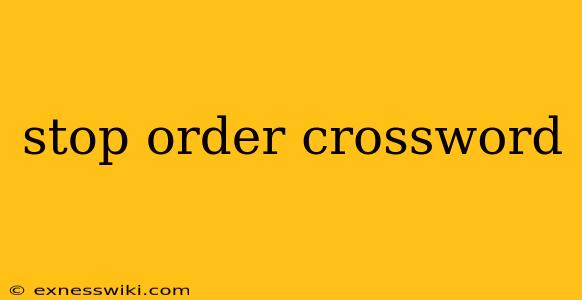Stop Order Crossword: Decoding the Market's Silent Language
Have you ever found yourself staring at a crossword puzzle, struggling to decipher the meaning of a seemingly simple clue? It's a feeling I've experienced more than once, especially when encountering the term "stop order." While it might sound like a confusing financial jargon, it's actually a powerful tool in the language of the stock market.
My own personal experience with stop orders came when I was a young investor, eager to make a quick buck. I had purchased shares of a tech company that was on a rapid rise, and I was excited to watch my portfolio soar. But then came the market correction - a sudden, unexpected drop. Panicked, I sold my shares, losing a significant amount of money.
In retrospect, a stop order could have saved me from that painful experience. A stop order is essentially a safety net for investors, automatically triggered when a stock reaches a specific price. It's like setting an alarm for your portfolio, ensuring you don't miss the mark even when the market gets volatile.
Let's delve deeper into the objective content:
- Stop-loss Orders: These are the most common type of stop orders, used to limit potential losses on a stock investment. They're triggered when the price of a stock falls below a specific level, selling your shares automatically and preventing further losses.
- Stop-limit Orders: These are similar to stop-loss orders but add an extra layer of protection. Instead of selling immediately when the stop price is hit, a stop-limit order only executes if the stock price reaches the specified limit price. This helps to avoid selling at a significant discount, especially during periods of high volatility.
Research from institutions like the Securities and Exchange Commission (SEC) has consistently shown that stop orders can be a valuable tool for managing risk. They provide investors with a level of control over their investments, allowing them to set predetermined limits for potential losses.
Here are a few helpful tips for incorporating stop orders into your investment strategy:
- Choose your stop price carefully: A stop price that's too tight may lead to premature selling, while a price that's too loose may not offer sufficient protection.
- Consider the volatility of the stock: More volatile stocks require tighter stop prices.
- Use stop orders in conjunction with other risk management techniques: Diversification and proper research are essential for building a sound investment strategy.
Overall, stop orders can be an invaluable tool for investors, but it's important to understand how they work and how to use them effectively. By incorporating them into your investment strategy, you can navigate the complexities of the market with a greater sense of control and security.
Remember my experience with the tech stock? By using a stop order, I could have potentially limited my losses and avoided a significant financial setback. The next time you're facing a tricky crossword clue or a volatile market, remember the power of stop orders - a silent but potent force in the language of investment.
